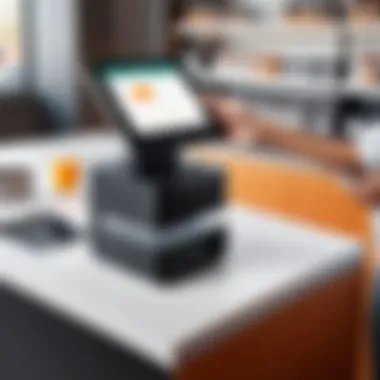An In-Depth Review of Square POS: Features and Benefits


https://en.wikipedia.org/wiki/Square,_Inc. https://www.britannica.com/topic/Square-Company
Prelude to Square POS
Understanding Square POS is essential for those exploring the realm of payment processing. The landscape is rapidly evolving, and Square POS stands out among its peers. This section addresses the meta aspects of Square POS, emphasizing its capabilities, significance, and various integrations.
Overview of Square
Square was founded in 2009 by Jack Dorsey and Jim McKelvey with a vision to simplify payments for small businesses. Over time, Square has developed into a multifaceted platform that not only offers transaction processing but also provides an impressive suite of tools that streamline various business operations. The core product, Square POS, facilitates real-time sales tracking, simplifies payment processing, and enhances customer engagement.
Given its user-friendly design and comprehensive service offerings, Square POS has carved a niche among small to medium-sized enterprises (SMEs). Acceptance of various payment methodologies adds to its attractiveness. Furthermore, this platform integrates easily with accounting tools for seamless financial management.
The emphasis on mobile applications reflects the growing trend towards flexibility in managing business transactions. Analysts constantly rate Square as a leading contender in mobile payments due to its innovative solutions. Many small businesses adopt Square due to the clear price structure and straightforward setup process.
Importantly, Square's system is compatible across different devices, making it versatile and accessible. Businesses appreciate having comprehensive financial analytics in one app, enhancing decision-making capabilities.
Evolution of POS Systems
The development of point of sale systems marks a significant milestone in the retail and service sectors. Traditional POS systems were bulky and required dedicated terminals. When credit cards were introduced, running wooden cash registers wasn't enough. The emergence of electronic cash registers took over, but adaptability was lacking.
With the rising importance of digital customer interactions, POS technology has changed dramatically. Today, Square POS demonstrates what modern systems can do. This includes processing orders, managing inventory, and generating sales data, all from a mobile device or tablet. Such advancement was originally limited to sophisticated systems used by major retailers.
Such historical improvement allows businesses of all sizes access to what was once available only to larger companies. They experience benefits like enhanced customer experiences and better operational efficiencies.
As payment practices shift—especially with contactless solutions and cryptocurrencies emerging—the importance of examining POS evolution cannot be understated. Understanding how we reached this point could prove integral for developers and IT professionals aiming to enhance integration with existing frameworks or create new functionalities.
Core Features of Square POS
The core features of Square POS form the backbone of its functionality and appeal. They are essential for businesses to streamline operations, enhance customer experiences, and manage finances effectively. Understanding these features helps potential users recognize what Square POS offers beyond basic transaction capabilities. Each feature contributes to creating a well-rounded system that addresses various business needs.
User Interface and Ease of Use
Square POS is renowned for its user-friendly interface. New users can navigate the platform with minimal instructions. Clear layouts and intuitive design simplify the process for business owners and their staff. The layout, where primary functions are prominently displayed, reduces the learning curve.
Ease of use directly influences operational efficiency. Shortening the time needed for training can improve service speed, equating to better customer satisfaction and potentially higher sales. Square regularly updates its interface, ensuring features align with modern user needs, continually refining how interaction occurs within the platform.
Payment Processing Capabilities
Payment processing is at the heart of any POS system, and Square excels in this area. It supports various payment methods, including credit cards, debit cards, and digital wallets. This flexibility is important; customers prefer different payment options.
Transaction speed remains a critical factor. Square is engineered for fast processing, so customers experience minimal wait time. Such moments can heavily influence customer perceptions during a visit. Square also incorporates robust security features to prevent data loss and fraud, giving users peace of mind.
Additionally, transaction fees are clearly detailed, allowing users to make informed financial decisions. Transparency around costs can build trust and simplify budgeting for small businesses.
Inventory Management Tools
Accurate inventory management remains essential for retail businesses. Square POS offers comprehensive tools for tracking stock levels in real time. Users can receive notifications when stock is low, preventing potential sales loss due to out-of-stock items. The simplicity of creating and updating inventory items is worth noting, particularly for those managing multiple products.
Users can categorize items, enabling effective searching and sorting. Furthermore, reports about inventory movement assist in understanding sales trends. Recognizing which items sell well enables effective stocking strategies and aids in sales forecasts.


Reporting and Analytics
Reporting capabilities transform raw sales data into actionable insights. Square POS features analytics tools that track business performance over time. When actionable data becomes accessible, businesses can explore key performance indicators; this informs strategies for customer engagement and inventory acquisition.
Users can generate reports ranging from daily sales summaries to detailed breakdowns over months. Such inclusivity helps users identify patterns and anomalies, which are critical for proactive business management.
Customer Relationship Management (CRM)
Strong CRM features help businesses build meaningful interactions with customers, foundational for loyalty. Through Square POS, users can store customer details, preferences, and purchasing history. Such information is invaluable for marketing purposes or personalized offers, allowing businesses to target previously engaged customers effectively.
The integration of communication tools, like email marketing, enhances connection without much effort. Owners team up with insights gathered from previous transactions. Elevating service for repeat clientele can influence business lifecycle trends positively.
Each of these core features reveals how versatile Square POS is for businesses of different sizes and types. Decision-makers should evaluate how these tools align with their specific operational strategies to optimize engagement and streamline financial processes.
Benefits of Using Square POS
Using Square Point of Sale system brings numerous advantages to businesses, from small retailers to larger establishments. The benefits extend beyond financial implications; they involve improved operational processes and strategic positioning in competitive markets. Understanding these aspects is essential to appreciate why more businesses opt for Square POS in an evolving payment landscape.
Cost-Effectiveness
Cost is a significant factor for many businesses when selecting a POS system. Square POS' pricing structure stands out for its simplicity and no hidden fees.
- Transparent Pricing: Square offers straightforward pricing. Businesses pay a flat percentage for each transaction, reducing confusion.
- No Monthly Fees: Unlike other POS systems, there's no monthly subscription required, which can save considerable amounts over time.
- Affordable Hardware Options: Square's hardware packages, like readers and terminals, come at competitive prices. Some setup options even allow for entry with little initial investment.
In summary, the cost-effectiveness of Square POS contributes to appealing profitability margins.o > *
Considerations When Choosing Square POS
When evaluating a Point of Sale system, selecting the right platform is crucial. Square POS offers several advantages, but potential users must be mindful of specific factors that impact their experience. Understanding the following setups ensures a more informed decision.
Pricing Structure and Fees
The pricing of Square POS is typically straightforward. Users should carefully review the associated costs. Square operates on a transaction fee model where fees apply to each sale. For in-person card swipes, this fee is 2.6% + 10¢ per transaction. However, other payments methods or late-night transactions may incur additional charges.
Moreover, understanding monthly subscription options can help manage the overall expense. Various tiers exist, including free versions with basic features and advanced packages that support complex functions. It is prudent to examine these costs deeply to prioritize what matters for your business's budget.
Hardware Requirements
Choosing Square POS requires careful consideration of the necessary hardware. Various options are available to meet the demands of distinct business settings. Most users opt for standard hardware components such as card readers, terminals, and tablets. Some Square products, however, work only with certain devices.
Business owners should assess their existing setups. Compatibility is essential. If you have preferred tablets or printers, confirm their functionality with Square's platform prior to purchase. In addition, reviewing brands like Apple, Android, and third-party equipment may enhance reliability and to ease of use, but it’s vital to ensure connections are seamless with Square’s system.
Support and Customer Service
The quality of customer support can make or break the experience with a POS system. Square has acknowledged this essential aspect and offers support across multiple channels, like chat, email, and phone. There are helpful online resources including a dedicated support page.
Nonetheless, experiences can vary. Square users should figure out atthe level of service needed for their operation’s success, and generally take time to explore feedback on support effectiveness on platforms such as Reddit or comparison sites. How quickly and efficiently customer inquiries are resolved can significantly affect ongoing operations and should factor into the decision-making process.
Before committing, assess profit margins alongside Square’s costs.
By weighing foundational considerations—such as pricing, hardware conformance, and customer support quality—businesses can confidently determine if Square POS is optimal for their unique needs.


Comparative Analysis of Square POS and Competitors
To effectively decide on a point of sale (POS) system, an comparative analysis of Square POS and its competitors is crucial. Each competing platform offers unique features, pricing structures, and capabilities, catering to different market segments. Evaluating these differences helps businesses discern their needs and measure the potential return on investment. Furthermore, financial considerations, integration compatibility, and relevant user experiences can significantly influence the decision-making process for potential users of Square POS.
Square POS vs.
Shopify POS
Both Square and Shopify offer robust features for retail businesses, but their core focuses differ. Square is rooted in providing a complete community format for payments, gift cards, and invoicing. In contrast, Shopify targets e-commerce platforms with built-in tools to build and manage online stores.
Ultimately, for businesses heavily reliant on online sales, Shopify POS integrates seamlessly with its e-commerce counterpart. However, space for brick-and-mortar operations? Square often delivers a more user-friendly approach. Reviewing aspects like ease of use, transaction fees, and customer support is vital here. Users have expressed differing experiences regarding which platform best meets their individual operational needs.
Square POS vs.
Vend
Vend is oriented towards retail, and it excels in inventory management. While Square provides inventory controls, Vend has extensive features enabling better tracking. This depth often appeals to large retailers with intricate inventory needs.
On pricing side, Square helps business owner anticipate costs with a clear fee structure. Vend's custom plans can lead to unclear costs, especially for smaller retailers fixed in fluctuating businesses. Consider, too, the training and support each offers. Square’s ease of use generally requires less onboarding than Vend’s complex functionalities.
Square POS vs.
Clover
Clover provides a feature-rich system attractive to various segments: restaurants, retailers, and service businesses. Like Square, Clover advantageously promotes easy integrations with other tools. However, Clover's distinct difference arises in its hardware options. Clover's variety means businesses have flexibility in hardware choices, but that can lead to confusion for newcomers.
Ultimately, the direct comparison involving pricing, functionality, and specific vertical inclination should form your decision-making tree. Users generally confirm that installation and support differ notably.
“In every business environment, it’s essential to synthesize workflows, reduce friction in cash flow, and facilitate ease of adaptation—choosing the right POS setup fosters those outcomes.”
By undertaking a thorough analysis of each system, businesses can ensure they align their operational objectives with the most suitable POS. Thus, it is key to weigh Square’s advantages and loopholes against other platforms before commitment.
Real-World Use Cases
Understanding real-world use cases of Square POS elucidates how varied industries utilize this payment processing system effectively. Businesses can observe potential advantages specific to their field, enhancing overall operational efficiency and customer experience. Real-time applications reflect the capabilities of Square and articulate its relevance in transactional settings. Particularly insightful, these use cases streamline workflows and embrace the ever-changing dynamics of commerce.
Retail Applications
Square POS delivers significant functionality for retail environments. Its intuitive interface enables employees to process transactions swiftly, reducing queues and waiting times. Front-facing features, like customer profiles, allow businesses to track purchase histories and suggest items based on preferences. This personalized service can substantially increase customer retention rates. Additionally, inventory management becomes seamless with Square. Retailers can monitor real-time stock levels, receive notifications for low inventory, and generate alerts for high-demand products. All these factors allow retail businesses to stay efficient and responsive.
Key benefits for retailers using Square POS include:
- Ease of Integration: Square syncs with several e-commerce platforms, making it versatile for both in-store and online sales.
- Detailed Analytics: Retailers can analyze sales data to find trends and improve inventory decisions.
- Mobile Payment Solutions: Offering customers mobile payment options aligns with modern purchasing behaviors.
Food and Beverage Industry Use
Applications of Square POS in the food and beverage sector signify operational improvements. With its capability for handling complex order types and varying menu items, Square POS develops an efficient flow from kitchen to table. Reporting features allow restaurants to manage lunch and dinner peak times by analyzing past sales trends. Another advantage includes the capability to split checks, add gratuities, or handle tip jars effectively.
The square service also supports contactless payments, which gains importance in today's health-conscious environment. Implementing Square helps establishments articulate value through customer convenience and operational flexibility.


Additional advantages for this sector include:
- Menu Management: Square enables easy updates to items and pricing, ensuring the menu remains relevant.
- Customer Engagement: Loyalty programs are easy to implement, directly aiding in repeat business.
- Comprehensive Reporting: Owners can view daily sales summaries, yearly trends, and employee performance reviews.
Service-Based Businesses
Service-based enterprises particularly benefit from Square POS’s advanced features. Professionals such as hairstylists, plumbers, or therapists gain from appointment scheduling integrated directly within the POS system. This synchronization maximizes time management, facilitating clear interactions between clients and service providers. Businesses can accept ledger payments right within their work areas, reducing delays and enhancing convenience for customers and workers alike.
Moreover, embedding client notes enables personalized services, vital for establishing long-term client relations. %cusps increases with follow-ups or referrals from past interactions. Maintaining a connection labels a business that values repeat patronage.
Notable pros for service-based businesses include:
- Simplified Invoicing: Square aids in generating and managing invoices smoothly with sparks transition to recurring services.
- Dynamic Client Management: Easy tracking of appointments and client histories fosters service enhancement initiatives.
- Adaptable Interfaces: The platform is applicable on various devices, removing hardware dependency and improving flexibility.
Square POS demonstrates capability across industries by specific functionality reflecting user needs and operational necessities.
Future Trends in Payment Processing
Understanding the future trends in payment processing is essential for any business looking to stay competitive in today's fast-evolving market. As the dynamics of transactions shift towards more efficient, user-friendly, and secure methods, services like Square POS must adapt. This necessity shapes its evolving features and functionalities, making familiarity with upcoming trends critical.
Impact of Mobile Payments
Mobile payments are growing rapidly, and their integration into businesses is becoming crucial. With the advent of smartphones and apps, consumers are increasingly comfortable using their devices for transactions. Sales via mobile payments are projected to exceed those made through traditional methods within the next few years.
- Convenience: Customers desire swift and seamless transactions. Square POS enables businesses to accept payments virtually anywhere, improving customer satisfaction.
- Increasing Expectations: Consumers expect more payment flexibility. Accepting mobile payments through Square can enhance service quality and drive repeat business.
- Technological Integration: Square’s proficiency shines when accepting payment methods such as Apple Pay and Google Pay, expanding user choices and simplifying processes.
This shift towards mobile transactions is reshaping customer expectations and loyalty. Retailers should be quick to adapt, as failing to integrate mobile payment options could result in lost customers.
Emerging Technologies
Innovations in technology will further transform payment processes. As newer solutions emerge, businesses must leverage these advancements, such as blockchain and advanced encryption methods.
- Blockchain Technology: Known for enhancing security, blockchain can help in preventing fraud, ensuring that transactions are secure and transparent. Incorporating blockchain concepts could take Square’s transaction security to the next level.
- Artificial Intelligence: AI is already playing a role in detecting anomalies in payment activities. Using AI-driven analytics can be beneficial in understanding consumer behavior and optimizing payment processes.
- Internet of Things (IoT): Devices connected through the IoT can also facilitate payment processing. Imagine making a purchase directly from a smart appliance, leading to a unique and profitable avenue for merchants.
The integration of these emerging technologies will push payment processing towards a more adaptive and secure direction, influencing how Square POS and its competitors shape their futures.
Staying informed about these emerging technologies is crucial for any payment processing stakeholders as they can provide new entry points for payment improvements. Adapting services alongside these trends will enable businesses to optimize their operations smoothly and respond to customer needs with agility.
Epilogue and Recommendations
In summary, the Conclusion and Recommendations section synthesizes the critical aspects of Square POS. It distills key insights garnered from the previous sections and offers actionable guidance for potential users. In a rapidly evolving retail environment, the functionalities and tools offered by Square POS can significantly streamline operations. It allows businesses to thrive amidst competition.
Final Thoughts on Square POS
Square POS stands out for its comprehensiveness and versatility. Its user-friendly interface, robust payment processing capabilities, and detailed reporting features make it a suitable choice for diverse types of businesses. The flexibility it provides is often mentioned by users as a key advantage. Particularly, smaller enterprises benefit from affordable pricing combined with a hardware setup that keeps expenses contained. As markets evolve, the emphasis on integrated data analytics will play a pivotal role in crafting business strategies. Users should generally find Square POS to be a reliable contender in the payment processing space.
Guiding Principles for Selection
When considering a point of sale system, certain principles can help aid in the decision-making process.
- Business Size and Type: Identify if Square POS fits your business model, regardless of whether it is retail, food service, or another sector.
- Cost-Effectiveness: Factor in both upfront costs and ongoing fees. Square’s transparent pricing is typically appealing.
- Integration Needs: Assess how well the software integrates with existing tools and workflows. This can avoid disruptions as you adopt a new system.
- Customer Support: Evaluate availability and responsiveness of customer service. Comprehensive support can ease potential operational hurdles during implementation.
Ultimately, recognizing the unique circumstances of each business will guide an informed choice about whether Square POS is the right fit.
"Investing in the right POS system is not just about transactions; it’s about empowering your business for growth."
By thoughtfully considering these guiding principles, businesses can leverage Square POS to its fullest, ensuring not only immediate operational efficiency but also long-term competitive advantage.







